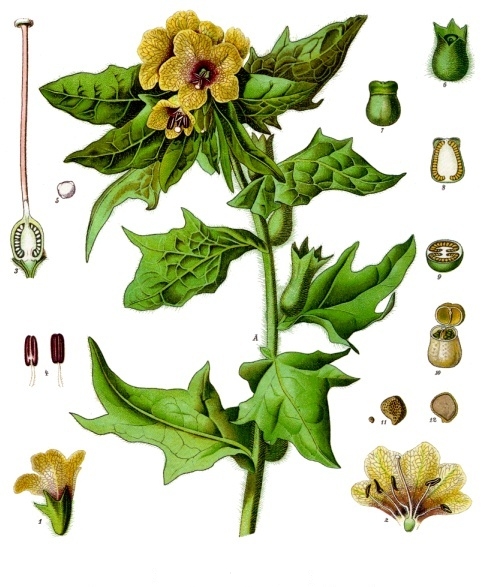- Hyoscyamus niger
Taxobox
name = Henbane

image_width = 240px
image_caption = Henbane
regnum =Plant ae
divisio =Magnoliophyta
classis =Magnoliopsida
ordo =Solanales
familia =Solanaceae
genus = "Hyoscyamus "
species = "H. niger"
binomial = "Hyoscyamus niger"
binomial_authority = L.Henbane ("Hyoscyamus niger"Harvnb|Roberts|1998|p=31.] ), also known as stinking nightshade, is a plant of the family
Solanaceae that originated inEurasia , though it is now globally distributed.Toxicity and historical usage
It was historically used in combination with other plants, such as mandrake,
deadly nightshade , anddatura as ananaesthetic potion, as well as for itspsychoactive properties in "magic brews."cite journal | url = http://www.jrsm.org/cgi/reprint/96/3/144.pdf | volume = 96 | date = March 2003 | journal = Journal of the Royal Society of Medicine | title = Myths and mandrakes | author = Anthony John Carter MB FFARCS | pages = 144–147 | pmc = 539425 ] cite journal | url = http://www.bmj.com/archive/7072ad4.htm | journal = British Medical Journal | date = 1996 December 21 | volume = 313 | issue = 7072 | pages = 1630–1632 | pmc = 2359130 | title = Narcosis and nightshade | author = A. J. Carter ] These psychoactive properties include visual hallucinations and a sensation of flight.Schultes & Smith 1976, p. 22] Its usage was originally in continental Europe, Asia and the Arabic world [Joseph Perez, Janet Lloyd, "The Spanish Inquisition", Yale University Press, 2006, ISBN 0300119828, ISBN 9780300119824, p229 footnote 10] ] , though it did spread to England sometime during theMiddle Ages . The use of Henbane by the ancient Greeks was documented by Pliny. The plant, recorded as "Herba Apollinaris", was used to yieldoracle s by the priestesses ofApollo .Henbane can be
toxic , even fatal, to animals in low doses. Its name dates at least to 1265. The origins of the word are unclear but "hen" probably originally meant death rather than referring tochicken s. [cite book | http://books.google.com/books?id=_m7k1Oi-cakC&pg=PA108&lpg=PA109&dq=henbane+An+Analytic+Dictionary+of+English&sig=ACfU3U3ClrwJijXR1g9Ort5gotA06qlZ0g | title = An Analytic Dictionary of English Etymology: An Introduction | author = Anatoly Liberman, J. Lawrence Mitchell | publisher = U of Minnesota Press | date = 2008 | isbn = 9780816652723 | pages = 108–110 ] .Hyoscyamine ,scopolamine , and othertropane alkaloids have been found in the foliage and seeds of the plant. Common effects of henbane ingestion in humans include hallucinations, dilated pupils, restlessness, and flushed skin. Less common symptoms such astachycardia , convulsions, vomiting,hypertension ,hyperpyrexia andataxia have all been noted.Not all animals are susceptible; the
larva e of someLepidoptera species includingCabbage Moth eat henbane.It was sometimes one of the ingredients in grut, traditionally used in
beers as a flavouring, until replaced by hops in the 11th to 16th centuries (for example, the Bavarian Purity Law of 1516 outlawed ingredients other than barley, hops, and water). [cite book | url = http://books.google.com/books?id=XRyxWu8rRnQC&pg=PR12&lpg=PR12&dq=grut+henbane&source=web&ots=VYmiB5FqRw&sig=e_OikTnvaSyfhlwoTJwvDaJrWPs&hl=en&sa=X&oi=book_result&resnum=8&ct=result | isbn = | pages = xii | title = The Dictionary of Beer and Brewing | author = Dan Rabin, Carl Forget | publisher = Taylor & Francis | date = 1998 | isbn = 9781579580780 ]In 1910, an American
homeopathic doctor living in London,Hawley Harvey Crippen , usedhyoscine , analkaloid extracted from henbane, to poison his wife. ["The Crippen Case – Discovery of Poison", "The Times", Wednesday, September 7th, 1910, p3]Henbane is thought to have been the "
hebenon " poured into the ear ofHamlet 's father [cite web | title = Hebenon | url = http://machaut.uchicago.edu/?action=search&word=hebenon&resource=Webster%27s&quicksearch=on | work = Webster's Revised Unabridged Dictionary (1913 + 1828)] (although other candidates for hebenon exist [cite book | url = http://books.google.com/books?id=_m7k1Oi-cakC&pg=PA110&lpg=PA110&dq=hebenon+henbane&source=web&ots=eu8dtBErXl&sig=KPYDD9SUuodWRIp6C0oJo3ooOF4&hl=en&sa=X&oi=book_result&resnum=3&ct=result | title = An Analytic Dictionary of English Etymology: An Introduction | author = Anatoly Liberman, J. Lawrence Mitchell | publisher = U of Minnesota Press | date = 2008 | isbn = 9780816652723 | pages = 110–111 ] ).Misidentification
In 2008 celebrity chef
Antony Worrall Thompson recommended Henbane as a "tasty addition to salads" in the August 2008 issue of "Healthy and Organic Living " magazine. He subsequently said that he had made an error, confusing the herb with Fat Hen, a member of the spinach family. He apologised, and the magazine sent subscribers an urgent message stating that Henbane "is a very toxic plant and should never be eaten." [cite news
title=TV chef Worrall Thompson recommends deadly weed as salad ingredient
url=http://www.guardian.co.uk/lifeandstyle/2008/aug/04/foodanddrink.foodsafety?gusrc=rss&feed=networkfront
work=The Guardian
date=August 4, 2008
accessdate=2008-08-04]ee also
*
Nabidh Notes
References
* Harvard reference
Surname1 = Roberts
Given1 = Margaret F.
Surname2 = Wink
Given2 = Michael
Year = 1998
Title = Alkaloids: biochemistry, ecology, and medicinal applications
Publisher = Springer
Pages = 31–32
ISBN = 0306454653
URL = http://books.google.com/books?vid=ISBN0306454653&id=bMCzyrAtrvYC&dq=henbane
Access-date = 2006-12-27.
* Harvard reference
Surname1 = Schultes
Given1 = Richard Evans
Surname2 = Smith
Given2 = Elmer W.
Year = 1976
Title = A Golden Guide to Hallucinogenic Plants
Publisher = Golden Press
URL = http://kosmicjourney.org/encyclopedia/archives/goldenguide.pdf
Access-date = 2008-05-26.
* Harvard reference
Surname1 = Clinicalmind.com
Title = Henbane
URL = http://www.clinicalmind.com/supplements/henbane.htm
Access-date = 2007-08-18.External links
*http://www.erowid.org/plants/henbane/henbane.shtml
* [http://www.weberseeds.de/species/hyoscyamus_albus.htm Hyoscyamus albus]
* [http://www.weberseeds.de/species/hyoscyamus_muticus.htm Hyoscyamus muticus]
* [http://www.weberseeds.de/species/hyoscyamus_niger.htm Hyoscyamus niger]
Wikimedia Foundation. 2010.
